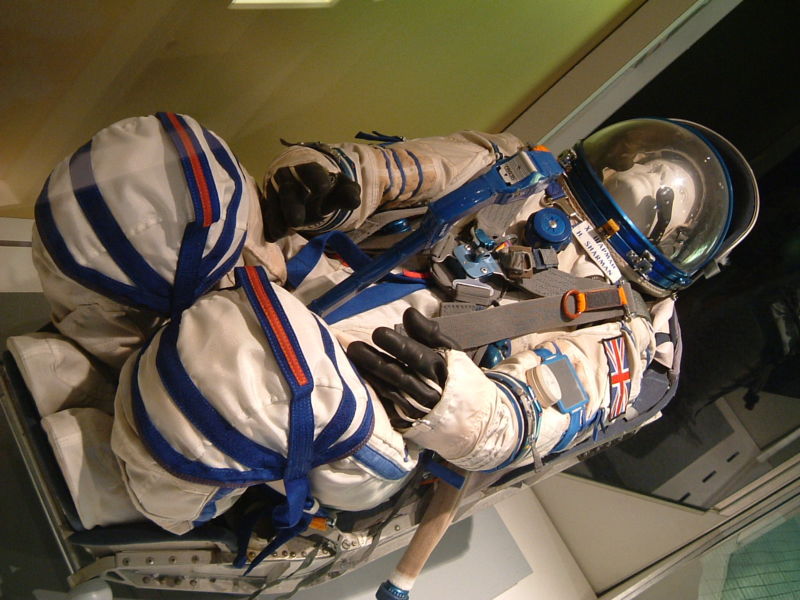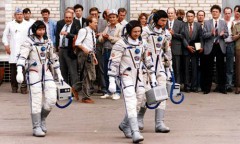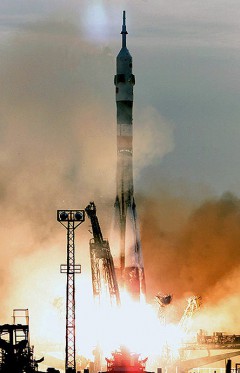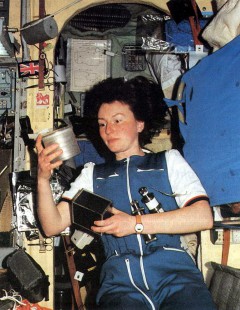
Aside from issues of politics and finance—discussed in yesterday’s article—the choice of Helen Sharman as the first Briton in space came on 19 February 1991, when Air Vice Marshal Peter Howard—former commandant of the Royal Air Force’s Institute of Aviation Medicine, aerospace physician, and veteran of the world’s first rocket-propelled ejection seat, who had been placed in charge of the Project Juno astronaut selection—arrived in Moscow for separate discussions with the two candidates. “They told me I was to be in the prime crew,” Sharman recalled in her autobiography, Seize the Moment. “This would be subject to a medical examination in March and another immediately before the launch.” Her backup, Army Air Corps Major Tim Mace, was characteristically gracious and the pair continued to work together, side by side, until, on 23 April, their formal training concluded. Less than a month remained before the launch of Soyuz TM-12.
Shoulder to shoulder with Sharman would be a pair of professional cosmonauts. In command of the mission was Anatoli Pavlovich Artsebarski, born in Prosyana, to the southeast of Kiev, within today’s independent Ukraine, on 9 September 1956. He graduated from the Soviet Air Force Institute in 1977 and was selected for cosmonaut training in September 1985, alongside the man who would serve as his flight engineer on Soyuz TM-12, Sergei Krikalev. Artsebarski’s first two years were spent preparing for the Buran shuttle project, but in 1987 he began working on Soyuz-TM and Mir. With Krikalev, he served on the backup crew for the joint Soviet-Japanese mission in December 1990. In Seize the Moment, Sharman described Artsebarski thus: “He’s a good organiser, pays attention to detail, and has great stamina—he’s always one of the last to leave a party.” That stamina would be amply tested during the summer of 1991, as Artsebarski and Krikalev were required to support no fewer than six EVAs, totaling almost 32 hours in the vacuum of space.
Sergei Konstantinovich Krikalev, meanwhile, was making the second of what would turn into a six-flight cosmonaut career and, at the time of writing, in early 2013, he holds the unchallenged record for having spent more cumulative time off the planet (803 days) than any other human being. Krikalev came from Leningrad—today’s St. Petersburg—where he was born on 27 August 1958; his father was an engineer and his mother a survivor of the Nazi siege of Leningrad. After high school, Krikalev specialised in chemistry and entered the Leningrad Mechanical Institute, graduating first in his class in 1981 with a degree in mechanical engineering. As part of his studies, he worked on the design and manufacturing of flight vehicles. Krikalev also served as an aircraft technician and learned to fly at a Leningrad aviation club. He joined Energia and was involved in the testing of space equipment and ground control operations; in fact, aged just 26, he worked on the Salyut 7 rescue team to develop contingency docking procedures with the inert station. (More than one source has commented that this work by Krikalev assured him of Soyuz T-13 commander Vladimir Dzhanibekov’s support in his application to become a cosmonaut.) Krikalev also excelled in athletics, swimming, and aerobatics, and was a member of the Soviet national flying teams, winning the accolade of Champion of Moscow in 1983 and Champion of the Soviet Union in 1986. By this time, he had entered cosmonaut training, having been selected in September 1985, and worked for a time on the Buran programme. He was officially appointed as a “test-cosmonaut” in February 1987 and flew his first mission aboard Soyuz TM-7.

Early on 18 May 1991, the prime crew and their backups—Alexander Volkov, Alexander Kaleri, and Tim Mace—stepped smartly through their final chores, in readiness for launch at Tyuratam. Out on the launch pad stood Soyuz TM-12 atop its rocket, whose nose shroud had been painted with both the Soviet Hammer and Sickle and the British Union Jack. Aboard the bus, Sharman was approached by Alexei Leonov, who offered her a number of “unofficial” items to carry aboard Mir: a Swiss army knife, a camera, several rolls of film … and a handful of grass. “I pick this for you,” he told her, paraphrased in Seize the Moment. “Take it with you into the space station. There’s nothing much to smell up there and this will remind you of home.” The sweet-scented grass was polin, a kind of wormwood, or absinthe, which grew ubiquitously over the steppe of Kazakhstan.
Liftoff occurred precisely on time at 3:50 p.m. Moscow Time, amidst what Sharman could only describe as a steadily increasing, though muffled, rumbling. “I could feel the vibration, but no sense of acceleration,” she wrote. Intellectually, she knew they must have left the ground, but was “in that momentary limbo where the rocket seems to balance precariously on its thrust, surely destined to topple.” Yet topple it did not, for the acceleration steadily began to increase as Soyuz TM-12 thundered toward orbit. Her ears and senses attuned to every nuance from the rocket, indoctrinated through months of training, Sharman heard and felt the passage of maximum aerodynamic turbulence and the separation of the rocket’s tapering strap-on boosters, until, finally, the escape tower and protective fairing was jettisoned, uncovering the capsule’s windows for the first time and admitting a flood of sunlight. “Dreams sometimes do come true,” Sharman mused in her autobiography, “and I felt so alive.”
By five minutes, the central core stage of the booster had also been expended and was jettisoned, taking with it a flurry of ice particles. And finally, at eight minutes, as objects within the cabin seemed to ponder the question of whether or not they were still governed by terrestrial gravity or instead were the subjects of orbital free-fall, came the separation of the upper stage and the abrupt suddenness of arrival in space. “It did not happen gradually,” Sharman wrote of the dying moments of the third stage. “One moment, it was burning ferociously behind me, in the next it stopped completely. One moment I was being pressed hard into my seat and in the next I was not. I had been straining against the G-force without realising I had been doing so.” In front of the cosmonauts’ eyes, the objects finally surrendered themselves to the peculiar state of “microgravity.” They were weightless.

Two days later, on 20 May, Soyuz TM-12 drew toward Mir for the last stages of what should have been an automated docking with the station. Then, at a distance of 200 km, a malfunction in the Kurs rendezvous system forced Artsebarski to assume manual control of the final approach, earlier than normal, and docking was successfully accomplished with the front port of Mir’s multiple docking adaptor and the visitors were quickly engulfed in bear hugs and a traditional bread-and-salt welcome from the resident crew, Viktor Afanasyev and Musa Manarov. With the dismal demise of much British commercial participation in the mission, Sharman’s experiment programme was almost exclusively designed by the Soviets, with a primary emphasis upon the life sciences. She wore electrodes to track her heart rate, monitored her mental co-ordination and reaction speed with the “Prognos” series of random light patterns, and took a dozen blood samples from the tips of her fingers each day. In this manner, she added “data points” to the standard monitoring of adaptation to weightlessness. Additionally, Sharman took air samples throughout Mir to assess the prevalence of dust in the station and participated in a number of “agricultural experiments.” She grew wheat seedlings and potato roots, carried 125,000 pansy seeds—which were placed in the Kvant-2 airlock, the portion of the station least shielded from space radiation, to promote genetic mutations—for British schoolchildren, and supported high-temperature semiconducting experiments. Other work focused on the growth of luciferase protein crystals and the exposure of ceramic films to the harsh vacuum of space. Finally, a significant portion of Sharman’s time was devoted to photography of the United Kingdom itself. Yet it was impossible to avoid the reality that much of the work was Soviet-devised, Soviet-orchestrated, and Soviet-financed. “Sharman will operate 17 biotechnological, medical, and technical experiments—all Soviet,” wrote Tim Furniss in Flight International, shortly before launch. With undisguised scorn, he added that “the British element of the Project Juno mission will be Sharman herself … ”
On the day after docking, 21 May, she was in the process of one of her radio contacts with British schools and happened to mention that Mir was experiencing difficulties with its solar arrays, caused by changes in orientation. Later, the level of background noise on the station fell dramatically from the normal 75 decibels, as fans, circulating pumps and other equipment, began shutting down. In Seize the Moment, Sharman related the eerie nature of the change as the five cosmonauts shared dinner in the base block. “The first fans to stop were those at the extremities of the station,” she wrote, “in the Kristall and two Kvant modules; shortly afterwards, the fans in the base block slowed down, then halted. From being a noisy place, the space station became silent. After the fans, the lights extinguished themselves … all we were left with was a solitary emergency fluorescent tube … ” A computer in the orientation system had failed some time ago, preventing the arrays from properly tracking the Sun, and as a consequence Mir’s storage batteries were quickly drained. When the station re-entered orbital sunlight, its orientation was adjusted in order that its batteries could be recharged. Afanasyev and Manarov, by now old hands with more than five months aboard the station, assured her that such power outages were commonplace. Fortunately, a replacement computer had been brought along by Soyuz TM-12.
In keeping with other “standard” international visits of this era, Sharman’s mission lasted a little under eight days, with undocking and the return to Earth scheduled for 26 May. She would come home with Afanasyev and Manarov, concluding their 175-day flight, aboard the old Soyuz TM-11 craft, leaving Artsebarski and Krikalev and the new Soyuz TM-12 behind. Planning at the time called for another mission—Soyuz TM-13, with an Austrian cosmonaut amongst its crew—to fly in October 1991, although the political and economic climate over the next few months was to change the Soviet Union beyond all recognition … as well as affecting the situation of the cosmonauts themselves. Few cosmonauts would be more affected by what happened in Russia in the latter half of 1991 than Sergei Krikalev.

Early on 26 May, at 9:13 a.m. Moscow Time, Soyuz TM-11 undocked from its berth at the Kvant-1 module and began the three-hour process of returning to Earth. As Viktor Afanasyev flew in formation with Mir and Manarov fired off photographs, Anatoli Artsebarski—a fan of the British pop/folk singer Tanita Tikaram—played out their final separation manoeuvre and departure with a tape of “World Outside Your Window,” given to him by Sharman. Shortly after noon, the irreversible retrofire burn was performed and by 12:38 p.m. the orbital and instrument modules had been jettisoned, leaving only the descent module to endure the searing hypersonic descent through the atmosphere. Eleven minutes later, the drogue parachutes deployed. Conditions at the landing site in north-central Kazakhstan, near the industrial city of Jezkazgan, were windy, and Sharman remembered that much of the final descent was spent moving laterally with respect to the ground. Fifteen metres from touchdown, a proximity indicator illuminated and she informed Afanasyev and Manarov to brace themselves. A few seconds later, and a couple of metres above the Kazakh steppe, solid-fuelled retrorockets fired to cushion the impact. Although the capsule quickly tipped over in the high winds and bounced hard, it was nevertheless a successful landing.
It was 1:03 p.m. Moscow Time and Britain’s first astronaut was safely home after a little under eight full days in space. At the conclusion of his second mission, Manarov became the undisputed record-holder for time in space, with a cumulative 541 days, easily eclipsing the 430 days of fellow cosmonaut Yuri Romanenko. Manarov would enter politics in the wake of his space career and served as a member of the Russian Duma. For her part, Helen Sharman embarked on a career in television and science promotion and applied unsuccessfully (as did Tim Mace) for admission into the European Space Agency’s astronaut corps in 1992 and 1998. Only Viktor Afanasyev would fly again, and he would command three more missions, bridging the conclusion of the Mir era and the beginning of the International Space Station. As for Sharman’s Soyuz TM-12 crewmates, Artsebarski would return to Earth in October 1991, according to pre-flight plans, and would never fly again. The case of Sergei Krikalev, though, would be far different as politics in Moscow took an ugly turn in mid-August. As circumstances transpired, Krikalev would not return to Earth until early 1992.
More than two decades have now passed since Helen Sharman inaugurated Britain’s adventure in human space exploration. Fellow “Britons” have followed in her footsteps, but not with the official support and sanction of the U.K. government: Mike Foale, Piers Sellers, and Nick Patrick—though born and raised in Britain—acquired U.S. citizenship in order to become NASA astronauts and flew with the Stars and Stripes on their shoulders. Others, including Mark Shuttleworth and Richard Garriott, flew as self-funded “space tourists.” However, in 2009 former Royal Army Air Corps helicopter pilot Tim Peake was selected as an astronaut candidate by the European Space Agency (ESA). Last week, in a blaze of publicity, he received an official assignment to an International Space Station mission in 2015-16. Whilst Sharman opened the door for U.K. astronauts to explore space, her legacy will be continued by Peake as the first official representative of the British government to fly a space mission.
This is part of a series of history articles, which will appear each weekend, barring any major news stories. Next week’s article will focus on Gemini IX-A, a dramatic mission in June 1966 which rose from the tragedy of a lost prime crew to a lost target spacecraft … and almost a lost spacewalker.
Want to keep up-to-date with all things space? Be sure to “Like” AmericaSpace on Facebook and follow us on Twitter:@AmericaSpace




It’s so riveting to read the story of Helen Sharman’s ride to space in yet another excellent Ben Evans’ article!
And I’m really happy for the UK, to finally officialy send a UK astronaut on the ISS. On the same time, I feel really sad and depressed, that my country, Greece, another member nation of ESA, chooses to continually ignore for decades, the realities of space travel, and the opportunities of what can be achieved through being a member of ESA.